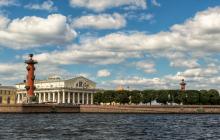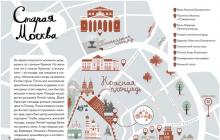The address: Russia, Moscow, 1st Ostankinskaya street, 5
Build date: 1798 year
Main attractions: Church of the Life-Giving Trinity, Front yard, Palace, Park
Coordinates: 55 ° 49 "29.8" N 37 ° 36 "53.1" E
Cultural heritage site of the Russian Federation
The formation of the architectural complex "Ostankino" took place over 4 centuries. The first mentions of it as the village of Ostashkino are found in the historical annals of the 16th century (1558). The owner of this area in the northern part of Moscow was then Vasily Shchelkalov, who built the wooden Trinity Church on the territory of his estate. With the onset of the Time of Troubles, the village was ravaged, and the church was burnt.
A bird's eye view of the Ostankino estate
Subsequently, the estate passed into the possession of Ivan Borisovich Cherkassky, on whose instructions the building of the shrine was erected anew. Work on its construction was carried out for 2 years - from 1625 to 1627. But this temple also burned down over time, and its place was taken by a 5-domed red brick church, trimmed with white carved stone and decorated with polychrome tiles. Here she still stands. Inside the church there is a carved 9-tier iconostasis, 2 tiers of which have survived from the time of the building's construction, and the rest were added in the 18th century.
The Ostankino estate with a large manor house, a garden and an unusual temple was so good that Empress Anna Ivanovna herself in 1730 came to its territory. In 1732, another empress, Elizaveta Petrovna, came here four times. The wedding ceremony of Varvara Cherkasskaya (the owner's daughter) with Count Sheremetev Peter Borisovich was also held here. With the death of the owner of Cherkassky, the estate passed into the possession of the Sheremetevs and remained their property from 1743 to 1917.
 View of the estate from the opposite side of the Ostankino pond
View of the estate from the opposite side of the Ostankino pond
In 1767, by the decision of Sheremetev P.B. the building of the church was supplemented by a bell tower, but the most serious changes related to the arrangement of the estate took place under Nikolai Petrovich, another member of the Sheremetev family. He started the construction of the palace and the breaking up of the park. With the death of Nikolai Petrovich, the estate found a new owner - in 1809 his 6-year-old son Dmitry became it, so over the next few years the palace was far from social life.
The beginning of the 1830s marks the beginning of a new period for the estate - its park is turning into a favorite place for Muscovites, regardless of their class. And from the second half of the same century, the palace revives again and becomes the center of attention. From the end of the 19th century, the estate turned into a good source of income for the owners - they built summer cottages here and rented them out for recreation.
In 1917, the owner of the estate Sheremetev, Alexander Dmitrievich, left Russia, and the entire Ostankino complex became the property of the state - the Commission for the Protection of Art and Antiquity of the Moscow City Council took care of it.
 Ostankino Estate Palace
Ostankino Estate Palace
Description of the palace of the Ostankino complex
The best architects of that time worked on the development of the palace project: Starov, Camporesi and Brenna. Construction work was carried out for 6 years (1792 - 1798) by the Mironovs and Argunovs, the serf architects of Sheremetev. The result of their labor was a wooden palace with plastered walls, which at first glance seem to be stone. The façade, painted in a pale pink color, had the unusual name "the color of a nymph at dawn". Due to the delicacy of the color and whiteness of the columns, the entire structure conveyed an extraordinary sense of purity. In general, the palace building became the embodiment of the Classicism style. The decoration of its main facade is a six-column Corinthian portico, standing on the ledge of the lower floor. And the decoration of the facade facing the park area is a 10-column Ionic loggia. On the outer walls of the palace there are bas-reliefs - the work of the famous sculptors Zamaraev and Gordeev. The main part of the palace is the theater hall, which, through closed galleries, connects with the pavilions - Egyptian and Italian.
 Temple of the Life-Giving Trinity
Temple of the Life-Giving Trinity
The interior decoration of the manor palace is striking in its simplicity and elegance. Most of the decor is made of wood, but it mimics a variety of expensive materials. When decorating the halls, only gilded carving was used. The carver Spol was responsible for all the carvings. In the Italian pavilion, the carved decor is unusual and beautiful - the patterned parquet is covered with the rarest types of wood, and its walls are upholstered with velvet and satin fabric. In all the state rooms there is gilded furniture made by Russian and European craftsmen in the 18th - early 19th centuries. All types of decorations and lamps were made especially for the palace of the Ostankino estate.
In the palace of the old Ostankino complex, there is a collection of portraits - these are the works of famous masters of the 18th - 19th centuries, and unique canvases by artists whose names remained unknown. Once upon a time, 30 genuine antique statues were kept in the palace, but, unfortunately, most of the ancient sculptures were lost for various reasons. And today, visitors to the palace can see only five of them. Among the porcelain items, there are items that were part of the collection of the Cherkassky family. All of these are ancient products from Chinese and Japanese porcelain. The collection of fans collected by the collector F.E. Vishnevsky attracts the attention of visitors.
 The park of the estate with a view of the "Milovzor" gazebo and decorative sculptures
The park of the estate with a view of the "Milovzor" gazebo and decorative sculptures
Ostankino Estate Theater - a place of entertainment for Muscovites
In the 18th century, going to the theater was considered a fashionable event. Nikolai Petrovich Sheremetev was also fond of theatrical art. Wanting to turn his palace into the Pantheon of Arts, he opened his own theater. The basis for the first production was Kozlovsky's opera The Capture of Izmail or Zelmir and Smelon. The theater troupe consisted of a couple of hundred actors, musicians and singers, and their repertoire consisted of operas, comedies and ballet. On the stage of the Ostankino Theater in Moscow, spectators saw performances of works by Russian and foreign composers.
In the premises of the theater, Count Sheremetev liked to organize celebrations in honor of noble persons arriving at the estate. In these cases, the most talented actors took part in the performances. The theatrical star of that time was the serf actress and singer Praskovya Zhemchugova. A holiday was also held in honor of the arrival of Alexander I, but it was already the last. At the beginning of the 19th century, the owners of the estate dissolved the theater and left the palace. To date, the theater hall has retained its "ballroom" look, and chamber orchestras still sound in it and staging of old operas are embodied. It is difficult to call it spacious, because no more than 250 people can admire the theatrical skills of the actors, but it is the best in the entire capital in terms of acoustics. Good acoustics is achieved here due to the shape in which the hall is built - it looks like a horseshoe. The color scheme of the theater hall is presented in blue and pink tones.
 Memorial to Volunteers of the 13th and 6th divisions of the people's militia who defended Moscow in the park of the estate
Memorial to Volunteers of the 13th and 6th divisions of the people's militia who defended Moscow in the park of the estate
Manor park Ostankino
Simultaneously with the construction work for the construction of the palace, work was also carried out to lay out the garden. Sheremetev himself decided to surround the palace with a regular park, laid out in the French style. Later he also created a landscape park. However, the first, regular park, formed the basis of the Amusement Garden, which had a parterre, a cedar grove, "Own Garden", and a loose hill. The amusement garden was adjacent to the palace building. The part of the cedar grove, which is closer to the estate, was called the Pribavochny Garden, but later it was turned into the English Park. All work on its creation was entrusted to the gardener - a real Englishman. Lindens and oaks, maples and hazel, viburnum and honeysuckle have successfully taken root in the garden. The park area was supplemented by 5 artificial ponds. Along Botanicheskaya Street, according to the owner's idea, a Sculpture Park was located. In addition to flower beds, statues and pavilions with columns, there is an open gallery and a stage.
 Manor park
Manor park
Modern life of the Ostankino estate
Since 1919, the estate acquired the status of a state museum, and the old church of the Life-giving Trinity became the courtyard of the Patriarch of Moscow and All Russia. The exposition of the Ostankino Palace opens its doors annually from May 19. In the summer months, the Sheremetev Seasons festival is held here, continuing the musical and theatrical traditions of the old estate. In addition to collections of graphics and paintings, the Ostankino Museum presents unique collections of lighting fixtures, furniture, wooden sculptures and ancient Russian icons.



